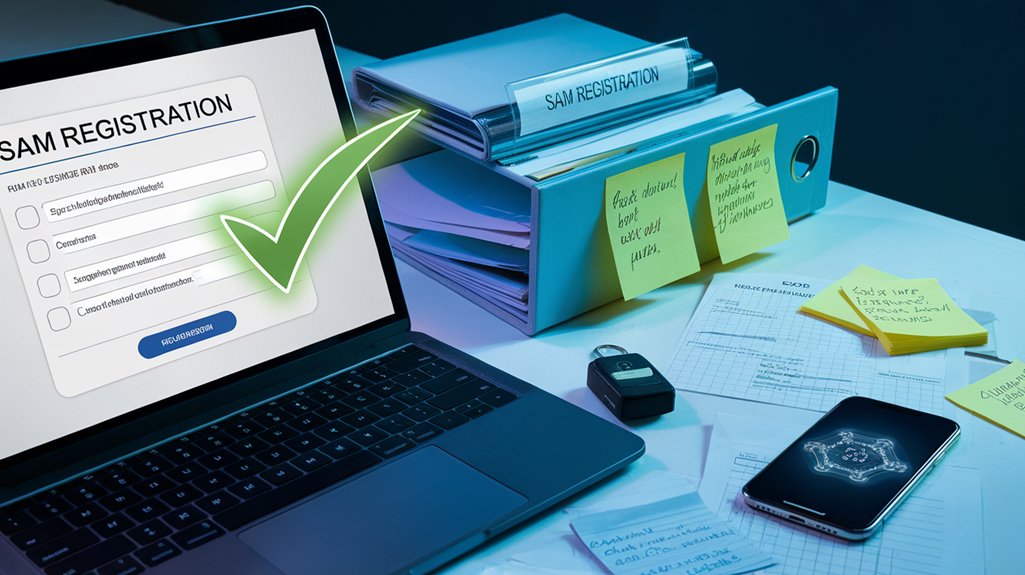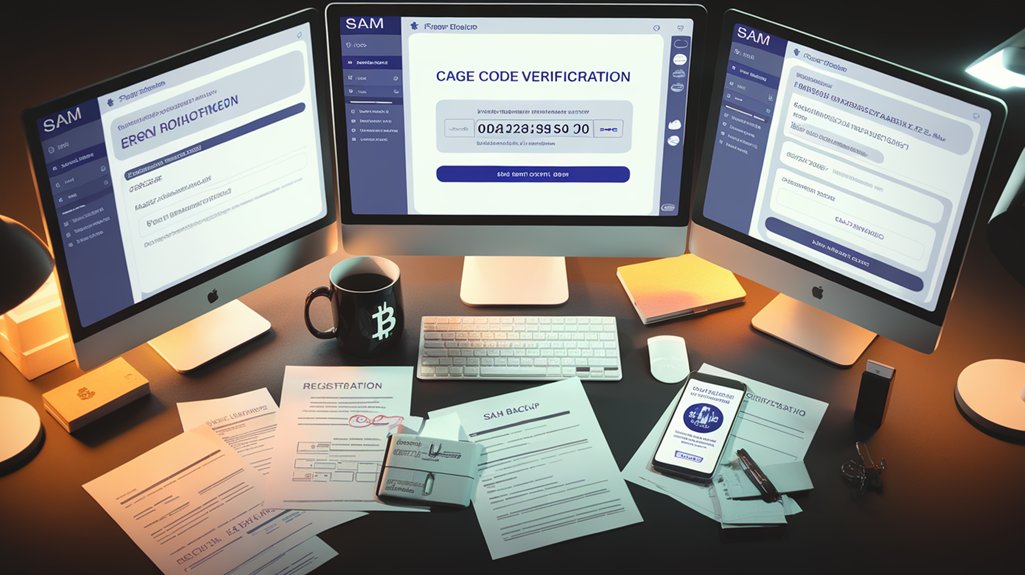Successful SAM registration requires meticulous attention to detail at every step. Common issues include mandatory field omissions, legal name mismatches with IRS records, and incorrect entity identification types. Organizations must align documentation precisely, maintain accurate secondary identifiers, and understand the distinction between entity registration and user accounts. Post-registration management demands regular profile updates and compliance monitoring to prevent suspension. The following solutions address these challenges through systematic verification processes and proactive maintenance strategies.
Overcoming Mandatory Field Omissions in SAM Applications

When organizations struggle with System for Award Management (SAM) registration, mandatory field omissions often represent the primary obstacle to successful submission. Applicants frequently overlook critical UEI verification steps, resulting in validation failures that prevent registration completion. Implementing application completeness tips can greatly reduce these errors. The validation process requires accurate matching between your entity information and government databases to avoid delays in processing.
SAM registration success hinges on meticulous attention to mandatory fields and proper UEI verification.
Organizations should establish a pre-submission checklist that verifies all mandatory field requirements, particularly focusing on entity information that must match government databases exactly. This approach improves mandatory field strategies by systematically addressing common pain points like TIN/UEI alignment and contact information verification. Failure to maintain continuous registration status could result in disqualification from federal contract opportunities. Securing proper assistance from third-party services like GSE can significantly streamline the registration process and help avoid common errors.
For best results, entities should:
- Cross-reference legal business names across all documentation
- Verify bank account information matches IRS records
- Designate individual email addresses for administrative contacts
- Allow 6-8 weeks for processing before existing registrations expire
- Monitor SAM.gov notifications for validation errors
Aligning Your Legal Business Name With Official Records

Precise alignment between your legal business name in SAM.gov and official government records serves as the foundation for successful registration. This critical step requires exact matching with IRS documentation compliance, including all suffixes such as LLC, Inc., or Corp.
Organizations frequently encounter validation failures due to minor discrepancies in name formatting or outdated records.
When submitting your SAM.gov application, remember that only the legal name registered with the IRS is acceptable. Trade names or DBAs require separate registration processes. The system cross-references your submission against federal databases to verify consistency.
For multi-structure organizations, each legal entity must maintain:
- Separate registrations with distinct legal names
- Unique EIN/TIN identifiers
- Properly documented parent-subsidiary relationships
If you discover a legal name mismatch post-submission, be aware that SAM.gov prohibits direct edits to this field. Instead, you must complete a full re-registration with a new Unique Entity ID after updating your IRS records.
Maintaining accurate records is essential for demonstrating vendor legitimacy and financial stability, which significantly impacts your competitiveness in securing government contracts.
Accurate Secondary Identifier Submission Strategies

The submission of accurate secondary identifiers represents a critical component of successful SAM.gov registration, often determining whether applications proceed smoothly or face bureaucratic delays. Organizations must guarantee precise identifier formatting according to jurisdiction-specific guidelines while maintaining consistency across all documentation.
The precision of secondary identifiers in SAM.gov registration directly impacts approval timelines and administrative outcomes.
For best results when submitting secondary identifiers, companies should:
- Cross-reference all tax IDs and registration numbers against the exact formatting requirements specified in SAM.gov’s jurisdiction alignment protocols.
- Upload translated English versions of international identifiers, guaranteeing all special characters comply with system requirements.
- Monitor the “Incident History” tab immediately after submission to address potential mismatches before they cause processing delays.
When international entities register, they must list all active tax jurisdictions in the “Global Entity” section, guaranteeing secondary identifiers align perfectly with primary registration numbers. This careful coordination prevents the common validation errors that often extend registration timelines. Remember that the registration process with proper secondary identifier submission can take up to 10 business days to complete, so plan accordingly to avoid funding application delays. Ensuring these details are correct is essential for federal contract eligibility and maintaining access to government business opportunities.
Resolving DUNS and SAM Information Mismatches

Information mismatches between DUNS and SAM systems represent one of the most common obstacles organizations face during registration. These discrepancies typically occur when company details aren’t perfectly aligned across both platforms, causing validation failures and registration delays.
When encountering mismatches, organizations should first contact Dun & Bradstreet to initiate DUNS updates. After changes are made, allow at least 24 hours for these modifications to propagate before attempting SAM verification again. During this process, guarantee all company identifiers—particularly the IRS TIN—match exactly in both systems. These small errors with abbreviations, punctuation, or inconsistent formatting can completely restart your application process.
Following the DUNS to UEI shift, organizations must be especially vigilant about data consistency. The transition to UEI numbers has created a more unified identification system for entities seeking federal funding. Implementing a detailed checklist of all required information helps ensure no critical elements are overlooked during the transition process. Regular audits of both profiles prevent future discrepancies.
The GSA Knowledge Base provides valuable troubleshooting resources for persistent issues.
Distinguishing Between Entity Registration and User Accounts

Many organizations encounter confusion when maneuvering the SAM.gov system because entity registrations and user accounts serve fundamentally different purposes within the federal procurement ecosystem.
The entity registration represents your organization as a whole, obtaining a Unique Entity ID for contracting purposes, while user accounts provide individual access to manage that registration with specific user permissions.
Proper management requires understanding these three key distinctions:
- Entity roles pertain to the organization itself, requiring renewal every 365 days, while user accounts control who can access and modify entity information.
- User permissions are assigned by entity administrators, determining who can update records, complete renewals, or view sensitive information.
- Security practices dictate that multiple administrators should manage entity registrations, ensuring continuous access even when personnel changes occur.
Understanding this separation prevents registration lapses and maintains proper access control throughout the federal procurement process. Municipalities must maintain active SAM registration status to continue receiving federal funding for construction projects and other government initiatives. Regular monitoring of renewal deadlines is critical to avoid suspension of your organization’s ability to participate in federal contracting opportunities.
Selecting the Appropriate Registration Intent for Your Goals

Choosing the correct registration intent in SAM.gov greatly impacts an organization’s ability to participate in federal opportunities. Organizations must align their registration with one of three primary purposes: bidding on contracts, applying for federal assistance, or engaging in other federal programs.
Registration Intent Clarification
The consequences of incorrect selection are significant. Entities seeking grants but selecting “contracts” face rejection delays and potential workflow restarts. Understanding your NAICS codes is essential when determining your registration intent, as these codes categorize your business activities for government procurement purposes.
Subrecipients receiving state-distributed funds should specifically select that option rather than full federal registration.
Selection Strategy Improvement
Best practices include:
- Reviewing the “Purpose Summary” screen before finalizing
- Using the “i” icon tooltips to clarify nuanced options
- Cross-referencing RFP/RFA requirements with registration intent
- Verifying entity type before goal selection
Organizations pursuing contracts require full registration including Core Data and Assertions, while assistance applications follow a slightly different path with specialized financial verification requirements. Upon initial registration, users must select the green “Get Started” button in their workspace to begin the process of creating a new entity record.
Navigating Grant vs. Contract Registration Options

The fundamental differences between grant and contract registration paths in SAM.gov create distinct requirements for organizations seeking federal funding. When registering, entities must clearly indicate their intent to pursue grants, contracts, or both, as this selection affects the information required and opportunities available.
Organizations should consider these critical differences when completing their registration:
- Intent Selection – Grant applicants primarily need basic entity information, while contract bidders require additional representations and certifications to qualify for procurement opportunities.
- Documentation Requirements – Contract registration demands more extensive financial information and compliance documentation than grant registration.
- Renewal Processes – Both registrations require annual renewal, but contract registrations face more rigorous verification steps.
Understanding these distinctions is essential for effective grant application tips implementation and developing successful contract bidding strategies.
Organizations should carefully assess their funding goals before selecting their registration type to avoid delays in accessing federal opportunities. Contract applicants should note that they will need to participate in a competitive bidding process after registration. Small businesses that complete proper registration gain access to set-aside contracts specifically designated for small business entities. Remember that the 6 to 8 weeks validation period for SAM registration must be completed before you’re eligible to apply for government funding.
Addressing CAGE Code Verification Challenges

Steering CAGE code verification presents significant hurdles for entities completing their SAM registration process. When CAGE code discrepancies arise, businesses must act promptly to resolve them or risk registration delays.
The Defense Logistics Agency (DLA) performs validation checks to prevent duplicate addresses in their system, notifying entities via email when validation fails. Common errors include incorrect addresses, missing information, or processing delays. Successful CAGE code validation is essential for businesses seeking to work with the U.S. federal government.
Effective DLA communication strategies can expedite resolution. When verification issues occur:
- Contact the DLA directly through their CAGE Search & Inquiry page
- Verify all address information matches exactly across all documentation
- Monitor registration progress using the SAM Entity Status Tracker
- Respond immediately to any validation failure notifications
Maintaining accurate entity information in SAM prevents most CAGE code issues.
For persistent CAGE validation problems, entities can reach out to DLA through specific contact methods including toll-free phone (1-877-352-2255), commercial line (1-269-961-7766), or email (dlacontactcenter@dla.mil).
Remember that CAGE codes are assigned at no cost, but accurate information is essential for successful validation alongside the required IRS TIN Match process.
Managing Business Document Verification Requirements

Because documentation plays a pivotal role in SAM registration, entities must prepare and submit precise business verification documents to complete the process successfully.
Creating a verification document checklist guarantees all requirements are met before submission, preventing delays in processing. Business document accuracy directly impacts approval timeframes and may trigger additional verification steps if discrepancies exist. Nonprofits should ensure they have prepared their EIN documentation and other essential paperwork before initiating the SAM registration process.
The most critical documentation requirements include:
- Legal Verification – Documents must clearly display the exact legal business name that matches IRS records and public registrations, including Articles of Incorporation or business licenses issued within the last five years.
- Address Confirmation – Physical address documentation must align with the address entered in the SAM system, verified through utility bills or official correspondence.
- Notarized Authorization – A properly executed notarized letter authorizing the individual registering the entity, including the legal business name and Unique Entity ID.
Responding to SAM Technical Glitches Effectively

While proper documentation establishes a foundation for SAM registration, technical challenges often present obstacles during the submission process. Understanding common system error solutions can prevent frustrating delays.
Solid preparation prevents SAM registration headaches, but knowing how to troubleshoot technical issues remains essential for success.
When encountering timeout errors during high-traffic periods, users should attempt registration during early morning hours when system usage is lower. For browser-related issues causing session timeouts, clearing cache and cookies often resolves these problems immediately.
Account access strategies include:
- Following specific password reset protocols through the Federal Service Desk for locked accounts
- Ensuring proper browser configurations when downloading FASCSA orders
- Addressing two-factor authentication failures by verifying phone numbers and email addresses
During scheduled maintenance periods (typically Tuesdays, Thursdays, and Fridays), users should postpone registration activities and resume after completion.
For urgent technical issues, live agent support is available Monday through Friday, 8 AM-8 PM ET, while web forms remain accessible 24/7 for non-emergency problems.
Regularly verify and update your banking information details in the SAM system to prevent payment delays and ensure smooth Electronic Funds Transfer processing.
Ensuring Email Communication Delivery From SAM

Nearly 40% of SAM registration issues stem from missed email communications that contain critical verification codes, renewal notices, and status updates. Organizations must implement robust email management protocols to prevent registration delays or unexpected deactivations.
Proper email authentication configurations greatly reduce the likelihood of SAM notifications being filtered as spam.
To optimize SAM email deliverability, organizations should:
- Implement proper SPF, DKIM, and DMARC protocols for domains used in SAM correspondence to strengthen email authentication and prevent filtering
- Designate dedicated personnel to monitor SAM-associated email accounts daily, with specific attention to spam folders
- Utilize business domain emails rather than free services like Gmail, as government systems often flag free email providers
Technical email configurations should be reviewed quarterly, with particular attention to server settings and spam filtering rules. Regular maintenance ensures your federal eligibility status remains active throughout the year. Failing to maintain active registration through proper email monitoring can result in disqualification from contracts even if your company meets all other requirements. An annual renewal is mandatory for SAM registration, regardless of whether any information has changed.
Organizations should also enable secondary notification methods, such as SMS alerts, to create redundancy in critical communications from SAM.gov.
Post-Registration Profile Maintenance Best Practices

Maintaining an accurate and current SAM profile after initial registration represents one of the most critical yet overlooked aspects of federal contracting compliance. Effective profile update strategies include establishing quarterly review schedules to systematically verify all sections and cross-referencing SAM data with internal business records to identify discrepancies. Companies should also verify their DUNS and CAGE codes are still valid and reflect current business operations according to federal requirements.
Organizations should follow these audit frequency recommendations:
- Conduct thorough quarterly reviews of contact information
- Validate NAICS codes and size standards annually
- Update legal business names and addresses immediately after organizational changes
- Review Representations & Certifications annually
- Submit renewal applications 60-90 days before expiration
Designating a primary SAM administrator with backup personnel prevents lapses during staff changes.
Additionally, maintaining detailed audit logs documenting changes, review dates, and unresolved issues provides an essential compliance trail that can prove invaluable during federal audits or inquiries. Setting up automatic reminders for SAM information reviews every 3-6 months helps ensure that your organization maintains consistent compliance with federal requirements. Failure to maintain accurate information can result in serious legal consequences, including potential False Claims Act violations and suspension from federal contracting opportunities.
Handling Government Assessment Requests

Federal agencies frequently initiate assessment requests after SAM registration submission, requiring organizations to provide additional verification of their business credentials.
These assessments typically arrive through the Federal Service Desk with a specific timeline for response, usually 3-5 business days. Organizations should maintain current contact information in their SAM profile to guarantee timely receipt of these inquiries. Failure to respond within the timeframe may result in your case being closed without review, as the FSD review process closes cases after 5 days without response. Understanding the various status indicators on your dashboard can help you track when assessments have been initiated.
When responding to government agency requests, follow these protocols:
- Submit all documentation in PDF/A format through the Federal Service Desk ticket system, using standardized email subject lines that include your SAM ID, entity name, and RFI number.
- Prepare notarized governing documents, financial statements, and ownership disclosure forms in advance to expedite assessment documentation requirements.
- Monitor SAM.gov status weekly during active assessments and confirm CAGE code issuance within 48 hours of approval.
Prompt responses to assessment requests prevent registration delays and maintain compliance with federal contracting requirements. Remember that the entire approval process typically takes 2-3 weeks when all documentation is properly submitted.
Maintaining Compliance to Prevent Registration Suspension

Beyond responding to government assessments, organizations must focus on regular SAM profile management to prevent unexpected registration suspensions.
Implementing robust compliance strategies involves tracking expiration dates and setting calendar reminders at least 60 days before renewal deadlines.
Registration updates should occur whenever business circumstances change, including address modifications, ownership transfers, or financial information updates.
Companies must review their SAM profiles quarterly to verify accuracy of all information, particularly NAICS codes and socio-economic certifications. Regularly conducting internal audits can help identify compliance issues before they trigger registration problems.
Businesses should designate a specific employee responsible for SAM maintenance, creating a formalized process for gathering updated information from various departments. Consistent compliance with regulations is crucial for maintaining eligibility for government contracting opportunities.
This individual should maintain documentation of all changes made to the registration.
Starting the renewal process early preparation helps prevent service disruptions and maintains eligibility for government contracts without interruption.
The most common suspension triggers include:
- Expired annual renewal
- Outdated financial information
- Unresolved government inquiries
- Changes in business status without corresponding updates
Resolving Entity Identification Type Errors

Identifying and resolving entity identification type errors represents one of the most challenging aspects of SAM registration management. When the Entity Validation Service flags discrepancies in your entity type classification, immediate action is required to prevent registration delays or suspension.
Entity type clarification often involves verifying how your business structure aligns with federal contracting categories.
To resolve identification errors effectively:
- Review your legal business documentation to ensure it matches the entity type selected in SAM, confirming that small business or disadvantaged business self-certifications are accurate.
- Conduct a thorough ownership structure analysis to properly identify all affiliations and parent-subsidiary relationships that might affect your entity classification.
- Submit corrections through the SAM Entity Status Tracker, providing supporting documentation that validates your correct entity type designation.
Misclassification can lead to serious compliance issues, including penalties for misrepresentation, making accurate entity identification essential for successful government contracting participation.
Maintaining consistent business names across all official documents is crucial, as name discrepancies are among the most common causes of entity identification validation failures.
Frequently Asked Questions
How Long Does a Typical SAM Registration Process Take?
The SAM registration timeline typically spans 2-8 weeks for full approval, with basic registration activation taking 7-10 business days after submission.
Various factors influence processing delays, including entity complexity, documentation issues, and system bottlenecks.
Organizations using third-party registration services may experience timeframes of 10-15 business days.
IRS-related requirements can add up to 5 additional weeks.
Pre-submission preparation, digital notarization, and professional assistance can considerably reduce overall registration time.
Can I Transfer My SAM Registration to a New Business Owner?
SAM registrations cannot be directly transferred to a new business owner.
When business ownership transfer occurs, the new owner must create a new SAM registration process with their own Unique Entity ID. This requires updating all documentation, including IRS validations and CAGE codes.
The previous registration should be deactivated once the new one is active.
Strategic planning is essential, as this process typically takes 7-15 business days for completion.
Does SAM Registration Automatically Qualify Me for Set-Aside Contracts?
SAM registration alone does not automatically qualify businesses for set-aside contracts. While registration is a mandatory first step, businesses must also meet specific eligibility criteria for each set-aside category.
These include proper socio-economic certifications (such as WOSB, VOSB, HUBZone, or 8a), compliance with SBA size standards, and demonstrated capability to perform contract requirements.
Additional documentation and verification processes are typically required beyond basic SAM registration to become eligible for these specialized contracting opportunities.
What Happens if My CAGE Code Application Is Rejected?
When a CAGE code application is rejected, the contractor faces immediate disqualification from government contracting opportunities.
The applicant receives application feedback detailing specific errors, with a 3-day window to submit corrections.
Rejection causes proposal disqualification, project delays, and competitive disadvantages while resolving issues.
Common rejection reasons include inactive SAM registrations, mismatched entity details, and address inconsistencies.
Contractors should cross-verify all information before submission and consider engaging PTAC advisors for pre-submission audits.
Are International Entities Eligible for SAM Registration?
Yes, international entities are eligible for SAM registration. Foreign organizations must have a legitimate U.S. business purpose, such as pursuing federal contracts or grants.
Registration requirements include obtaining an NCAGE code before applying, securing a Unique Entity ID (UEI), and providing business documentation.
While international registrants are exempt from Tax Identification Number requirements (if without U.S. tax obligations), they must still comply with U.S. federal regulations governing contracts.